Lin Tian
Learning to Make Friends: Coaching LLM Agents toward Emergent Social Ties
Oct 22, 2025Abstract:Can large language model (LLM) agents reproduce the complex social dynamics that characterize human online behavior -- shaped by homophily, reciprocity, and social validation -- and what memory and learning mechanisms enable such dynamics to emerge? We present a multi-agent LLM simulation framework in which agents repeatedly interact, evaluate one another, and adapt their behavior through in-context learning accelerated by a coaching signal. To model human social behavior, we design behavioral reward functions that capture core drivers of online engagement, including social interaction, information seeking, self-presentation, coordination, and emotional support. These rewards align agent objectives with empirically observed user motivations, enabling the study of how network structures and group formations emerge from individual decision-making. Our experiments show that coached LLM agents develop stable interaction patterns and form emergent social ties, yielding network structures that mirror properties of real online communities. By combining behavioral rewards with in-context adaptation, our framework establishes a principled testbed for investigating collective dynamics in LLM populations and reveals how artificial agents may approximate or diverge from human-like social behavior.
Estimating Online Influence Needs Causal Modeling! Counterfactual Analysis of Social Media Engagement
May 25, 2025Abstract:Understanding true influence in social media requires distinguishing correlation from causation--particularly when analyzing misinformation spread. While existing approaches focus on exposure metrics and network structures, they often fail to capture the causal mechanisms by which external temporal signals trigger engagement. We introduce a novel joint treatment-outcome framework that leverages existing sequential models to simultaneously adapt to both policy timing and engagement effects. Our approach adapts causal inference techniques from healthcare to estimate Average Treatment Effects (ATE) within the sequential nature of social media interactions, tackling challenges from external confounding signals. Through our experiments on real-world misinformation and disinformation datasets, we show that our models outperform existing benchmarks by 15--22% in predicting engagement across diverse counterfactual scenarios, including exposure adjustment, timing shifts, and varied intervention durations. Case studies on 492 social media users show our causal effect measure aligns strongly with the gold standard in influence estimation, the expert-based empirical influence.
Reference-Free 3D Reconstruction of Brain Dissection Photographs with Machine Learning
Mar 13, 2025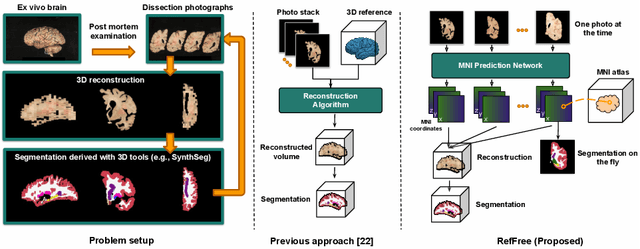

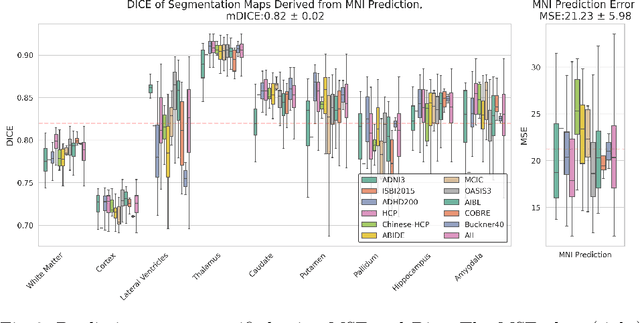
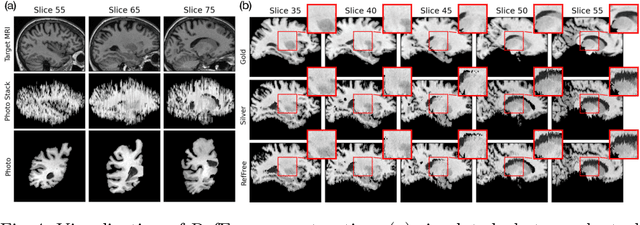
Abstract:Correlation of neuropathology with MRI has the potential to transfer microscopic signatures of pathology to invivo scans. Recently, a classical registration method has been proposed, to build these correlations from 3D reconstructed stacks of dissection photographs, which are routinely taken at brain banks. These photographs bypass the need for exvivo MRI, which is not widely accessible. However, this method requires a full stack of brain slabs and a reference mask (e.g., acquired with a surface scanner), which severely limits the applicability of the technique. Here we propose RefFree, a dissection photograph reconstruction method without external reference. RefFree is a learning approach that estimates the 3D coordinates in the atlas space for every pixel in every photograph; simple least-squares fitting can then be used to compute the 3D reconstruction. As a by-product, RefFree also produces an atlas-based segmentation of the reconstructed stack. RefFree is trained on synthetic photographs generated from digitally sliced 3D MRI data, with randomized appearance for enhanced generalization ability. Experiments on simulated and real data show that RefFree achieves performance comparable to the baseline method without an explicit reference while also enabling reconstruction of partial stacks. Our code is available at https://github.com/lintian-a/reffree.
Before It's Too Late: A State Space Model for the Early Prediction of Misinformation and Disinformation Engagement
Feb 07, 2025Abstract:In today's digital age, conspiracies and information campaigns can emerge rapidly and erode social and democratic cohesion. While recent deep learning approaches have made progress in modeling engagement through language and propagation models, they struggle with irregularly sampled data and early trajectory assessment. We present IC-Mamba, a novel state space model that forecasts social media engagement by modeling interval-censored data with integrated temporal embeddings. Our model excels at predicting engagement patterns within the crucial first 15-30 minutes of posting (RMSE 0.118-0.143), enabling rapid assessment of content reach. By incorporating interval-censored modeling into the state space framework, IC-Mamba captures fine-grained temporal dynamics of engagement growth, achieving a 4.72% improvement over state-of-the-art across multiple engagement metrics (likes, shares, comments, and emojis). Our experiments demonstrate IC-Mamba's effectiveness in forecasting both post-level dynamics and broader narrative patterns (F1 0.508-0.751 for narrative-level predictions). The model maintains strong predictive performance across extended time horizons, successfully forecasting opinion-level engagement up to 28 days ahead using observation windows of 3-10 days. These capabilities enable earlier identification of potentially problematic content, providing crucial lead time for designing and implementing countermeasures. Code is available at: https://github.com/ltian678/ic-mamba. An interactive dashboard demonstrating our results is available at: https://ic-mamba.behavioral-ds.science.
multiGradICON: A Foundation Model for Multimodal Medical Image Registration
Aug 01, 2024
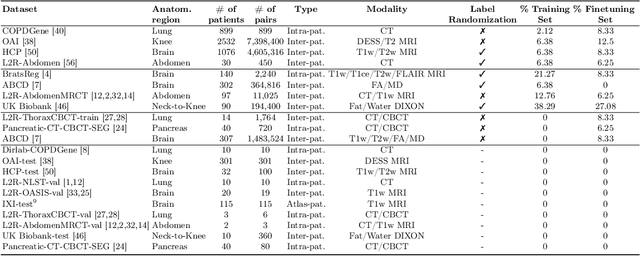
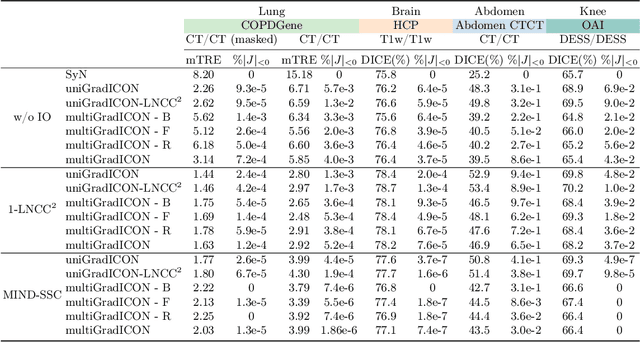
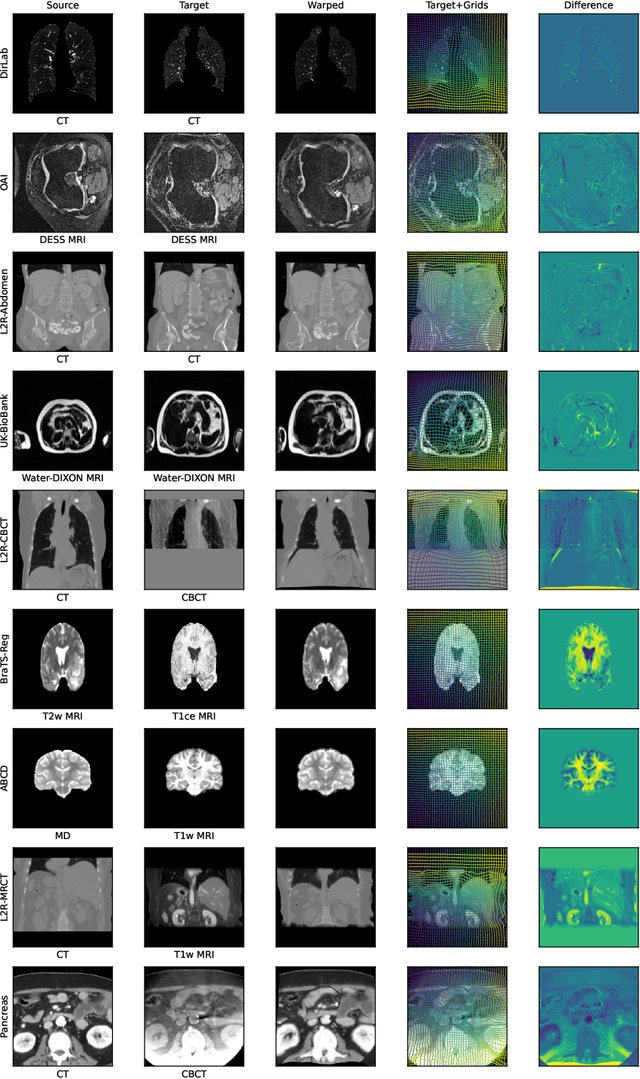
Abstract:Modern medical image registration approaches predict deformations using deep networks. These approaches achieve state-of-the-art (SOTA) registration accuracy and are generally fast. However, deep learning (DL) approaches are, in contrast to conventional non-deep-learning-based approaches, anatomy-specific. Recently, a universal deep registration approach, uniGradICON, has been proposed. However, uniGradICON focuses on monomodal image registration. In this work, we therefore develop multiGradICON as a first step towards universal *multimodal* medical image registration. Specifically, we show that 1) we can train a DL registration model that is suitable for monomodal *and* multimodal registration; 2) loss function randomization can increase multimodal registration accuracy; and 3) training a model with multimodal data helps multimodal generalization. Our code and the multiGradICON model are available at https://github.com/uncbiag/uniGradICON.
CARL: A Framework for Equivariant Image Registration
May 28, 2024
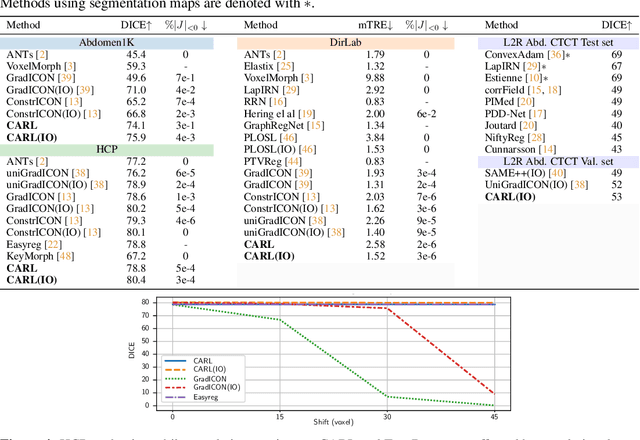
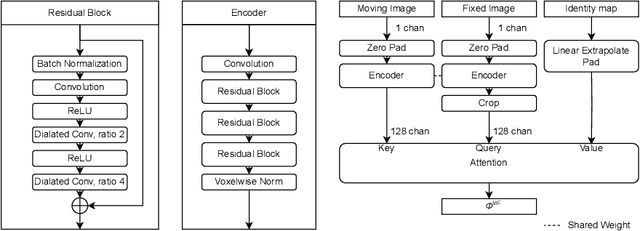
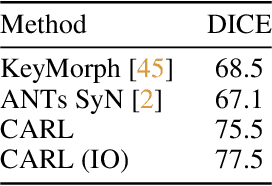
Abstract:Image registration estimates spatial correspondences between a pair of images. These estimates are typically obtained via numerical optimization or regression by a deep network. A desirable property of such estimators is that a correspondence estimate (e.g., the true oracle correspondence) for an image pair is maintained under deformations of the input images. Formally, the estimator should be equivariant to a desired class of image transformations. In this work, we present careful analyses of the desired equivariance properties in the context of multi-step deep registration networks. Based on these analyses we 1) introduce the notions of $[U,U]$ equivariance (network equivariance to the same deformations of the input images) and $[W,U]$ equivariance (where input images can undergo different deformations); we 2) show that in a suitable multi-step registration setup it is sufficient for overall $[W,U]$ equivariance if the first step has $[W,U]$ equivariance and all others have $[U,U]$ equivariance; we 3) show that common displacement-predicting networks only exhibit $[U,U]$ equivariance to translations instead of the more powerful $[W,U]$ equivariance; and we 4) show how to achieve multi-step $[W,U]$ equivariance via a coordinate-attention mechanism combined with displacement-predicting refinement layers (CARL). Overall, our approach obtains excellent practical registration performance on several 3D medical image registration tasks and outperforms existing unsupervised approaches for the challenging problem of abdomen registration.
uniGradICON: A Foundation Model for Medical Image Registration
Mar 09, 2024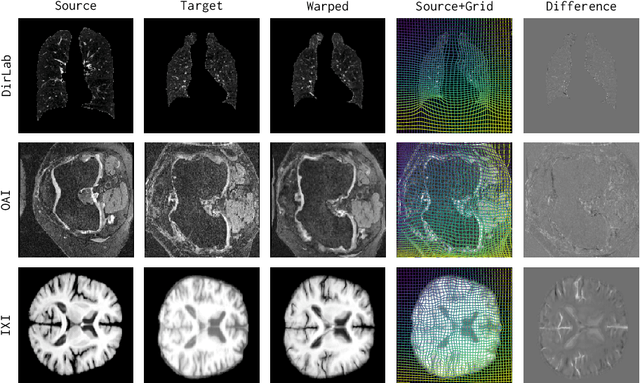
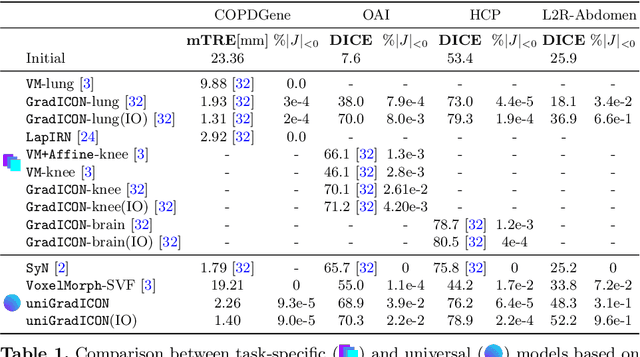

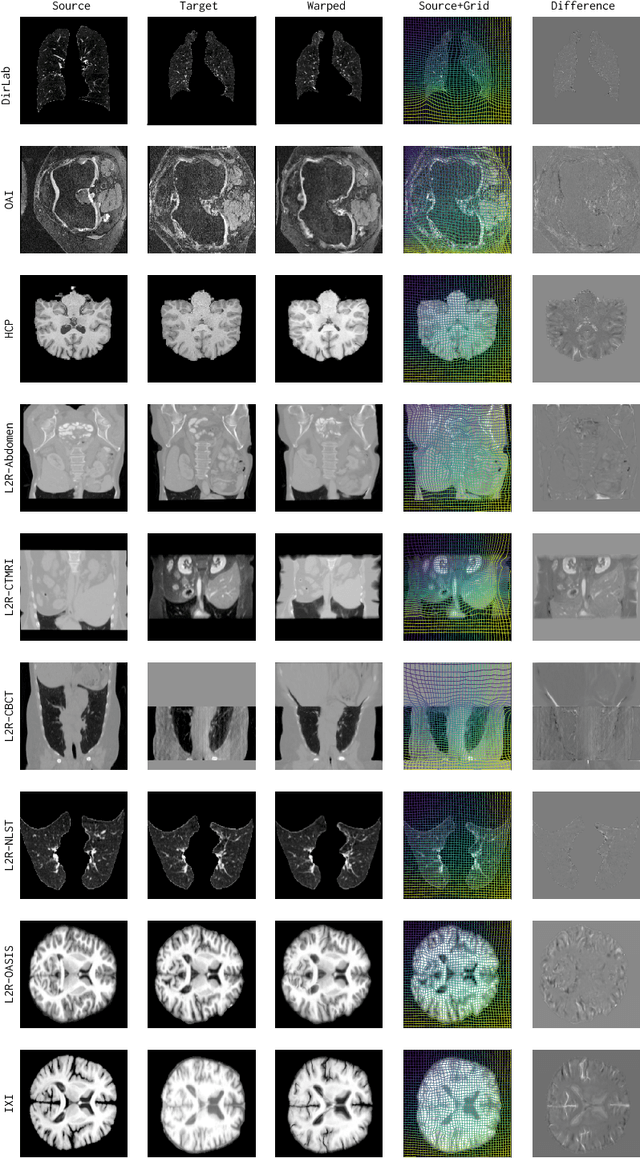
Abstract:Conventional medical image registration approaches directly optimize over the parameters of a transformation model. These approaches have been highly successful and are used generically for registrations of different anatomical regions. Recent deep registration networks are incredibly fast and accurate but are only trained for specific tasks. Hence, they are no longer generic registration approaches. We therefore propose uniGradICON, a first step toward a foundation model for registration providing 1) great performance \emph{across} multiple datasets which is not feasible for current learning-based registration methods, 2) zero-shot capabilities for new registration tasks suitable for different acquisitions, anatomical regions, and modalities compared to the training dataset, and 3) a strong initialization for finetuning on out-of-distribution registration tasks. UniGradICON unifies the speed and accuracy benefits of learning-based registration algorithms with the generic applicability of conventional non-deep-learning approaches. We extensively trained and evaluated uniGradICON on twelve different public datasets. Our code and the uniGradICON model are available at https://github.com/uncbiag/uniGradICON.
CMA-R:Causal Mediation Analysis for Explaining Rumour Detection
Feb 13, 2024Abstract:We apply causal mediation analysis to explain the decision-making process of neural models for rumour detection on Twitter. Interventions at the input and network level reveal the causal impacts of tweets and words in the model output. We find that our approach CMA-R -- Causal Mediation Analysis for Rumour detection -- identifies salient tweets that explain model predictions and show strong agreement with human judgements for critical tweets determining the truthfulness of stories. CMA-R can further highlight causally impactful words in the salient tweets, providing another layer of interpretability and transparency into these blackbox rumour detection systems. Code is available at: https://github.com/ltian678/cma-r.
Walert: Putting Conversational Search Knowledge into Action by Building and Evaluating a Large Language Model-Powered Chatbot
Jan 14, 2024


Abstract:Creating and deploying customized applications is crucial for operational success and enriching user experiences in the rapidly evolving modern business world. A prominent facet of modern user experiences is the integration of chatbots or voice assistants. The rapid evolution of Large Language Models (LLMs) has provided a powerful tool to build conversational applications. We present Walert, a customized LLM-based conversational agent able to answer frequently asked questions about computer science degrees and programs at RMIT University. Our demo aims to showcase how conversational information-seeking researchers can effectively communicate the benefits of using best practices to stakeholders interested in developing and deploying LLM-based chatbots. These practices are well-known in our community but often overlooked by practitioners who may not have access to this knowledge. The methodology and resources used in this demo serve as a bridge to facilitate knowledge transfer from experts, address industry professionals' practical needs, and foster a collaborative environment. The data and code of the demo are available at https://github.com/rmit-ir/walert.
SAME++: A Self-supervised Anatomical eMbeddings Enhanced medical image registration framework using stable sampling and regularized transformation
Nov 25, 2023Abstract:Image registration is a fundamental medical image analysis task. Ideally, registration should focus on aligning semantically corresponding voxels, i.e., the same anatomical locations. However, existing methods often optimize similarity measures computed directly on intensities or on hand-crafted features, which lack anatomical semantic information. These similarity measures may lead to sub-optimal solutions where large deformations, complex anatomical differences, or cross-modality imagery exist. In this work, we introduce a fast and accurate method for unsupervised 3D medical image registration building on top of a Self-supervised Anatomical eMbedding (SAM) algorithm, which is capable of computing dense anatomical correspondences between two images at the voxel level. We name our approach SAM-Enhanced registration (SAME++), which decomposes image registration into four steps: affine transformation, coarse deformation, deep non-parametric transformation, and instance optimization. Using SAM embeddings, we enhance these steps by finding more coherent correspondence and providing features with better semantic guidance. We extensively evaluated SAME++ using more than 50 labeled organs on three challenging inter-subject registration tasks of different body parts. As a complete registration framework, SAME++ markedly outperforms leading methods by $4.2\%$ - $8.2\%$ in terms of Dice score while being orders of magnitude faster than numerical optimization-based methods. Code is available at \url{https://github.com/alibaba-damo-academy/same}.
 Add to Chrome
Add to Chrome Add to Firefox
Add to Firefox Add to Edge
Add to Edge